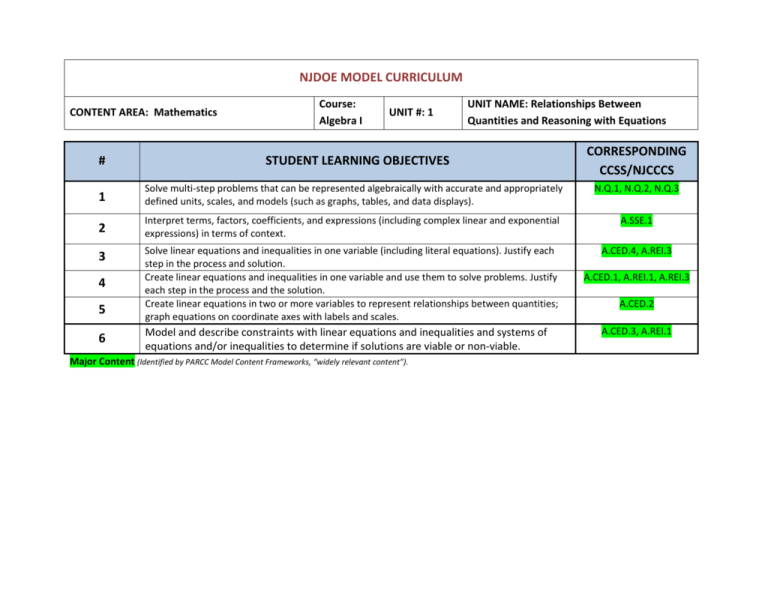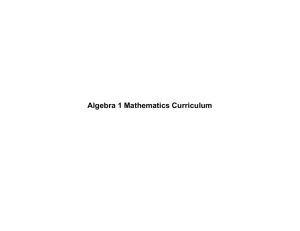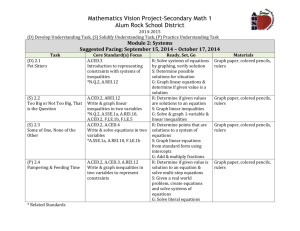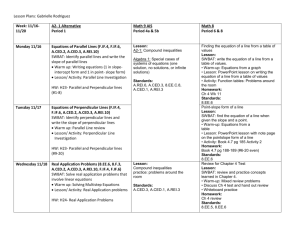NJDOE MODEL CURRICULUM CONTENT AREA: Mathematics
advertisement

NJDOE MODEL CURRICULUM CONTENT AREA: Mathematics # Course: Algebra I UNIT #: 1 UNIT NAME: Relationships Between Quantities and Reasoning with Equations STUDENT LEARNING OBJECTIVES CORRESPONDING CCSS/NJCCCS 1 Solve multi-step problems that can be represented algebraically with accurate and appropriately defined units, scales, and models (such as graphs, tables, and data displays). N.Q.1, N.Q.2, N.Q.3 2 Interpret terms, factors, coefficients, and expressions (including complex linear and exponential expressions) in terms of context. A.SSE.1 Solve linear equations and inequalities in one variable (including literal equations). Justify each step in the process and solution. Create linear equations and inequalities in one variable and use them to solve problems. Justify each step in the process and the solution. Create linear equations in two or more variables to represent relationships between quantities; graph equations on coordinate axes with labels and scales. A.CED.4, A.REI.3 3 4 5 6 Model and describe constraints with linear equations and inequalities and systems of equations and/or inequalities to determine if solutions are viable or non-viable. Major Content (Identified by PARCC Model Content Frameworks, “widely relevant content”). A.CED.1, A.REI.1, A.REI.3 A.CED.2 A.CED.3, A.REI.1 NJDOE MODEL CURRICULUM CONTENT AREA: Mathematics Code # N.Q.1 N.Q.2 N.Q.3 A.SSE.1 A.CED.1 A.CED.2 A.CED.3 A.CED.4 A.REI.1 A.REI.3 Course: Algebra I UNIT #: 1 UNIT NAME: Relationships Between Quantities and Reasoning with Equations Common Core State Standards Use units as a way to understand problems and to guide the solution of multi-step problems; choose and interpret units consistently in formulas; choose and interpret the scale and the origin in graphs and data displays. Define appropriate quantities for the purpose of descriptive modeling. Choose a level of accuracy appropriate to limitations on measurement when reporting quantities. Interpret expressions that represent a quantity in terms of its context.★ a. Interpret parts of an expression, such as terms, factors, and coefficients. b. Interpret complicated expressions by viewing one or more of their parts as a single entity. For example, interpret P(1+r)n as the product of P and a factor not depending on P. Create equations and inequalities in one variable and use them to solve problems. Include equations arising from linear functions. Create equations in two or more variables to represent relationships between quantities; graph equations on coordinate axes with labels and scales. Represent constraints by equations or inequalities, and by systems of equations and/or inequalities, and interpret solutions as viable or non-viable options in a modeling context. For example, represent inequalities describing nutritional and cost constraints on combinations of different foods. Rearrange formulas to highlight a quantity of interest, using the same reasoning as in solving equations. For example, rearrange Ohm’s law V = IR to highlight resistance R. Explain each step in solving a simple equation as following from the equality of numbers asserted at the previous step, starting from the assumption that the original equation has a solution. Construct a viable argument to justify a solution method. Solve linear equations and inequalities in one variable, including equations with coefficients represented by letters. Major Content (Identified by PARCC Model Content Frameworks, “widely relevant content”).









